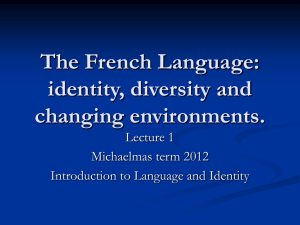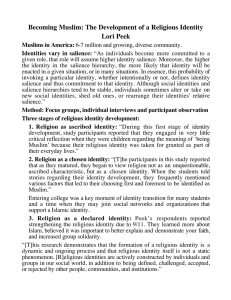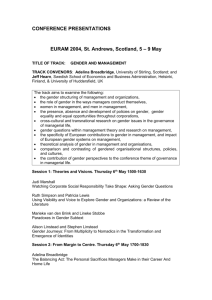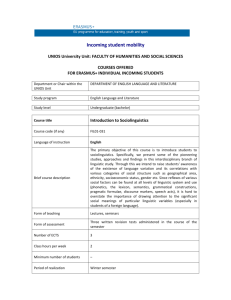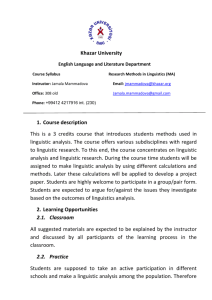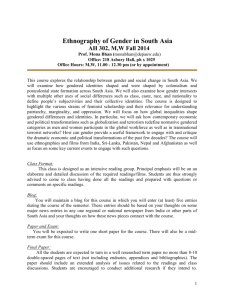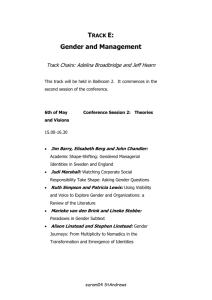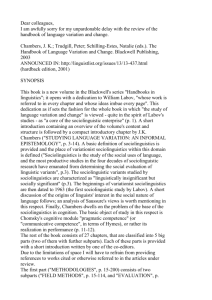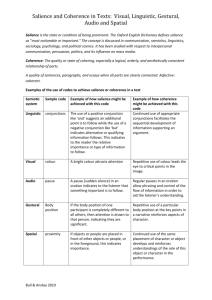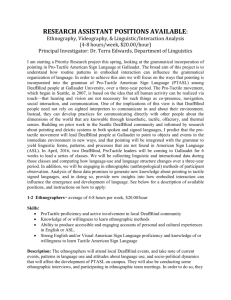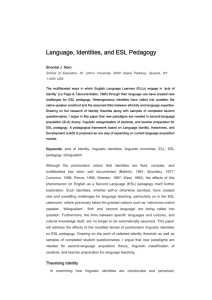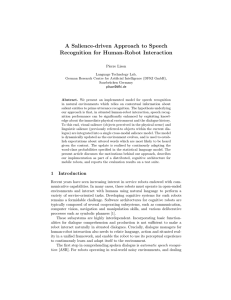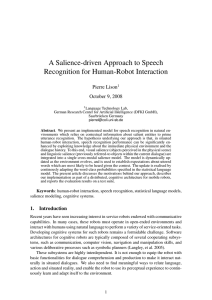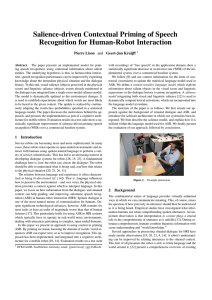Gender - WordPress.com
advertisement
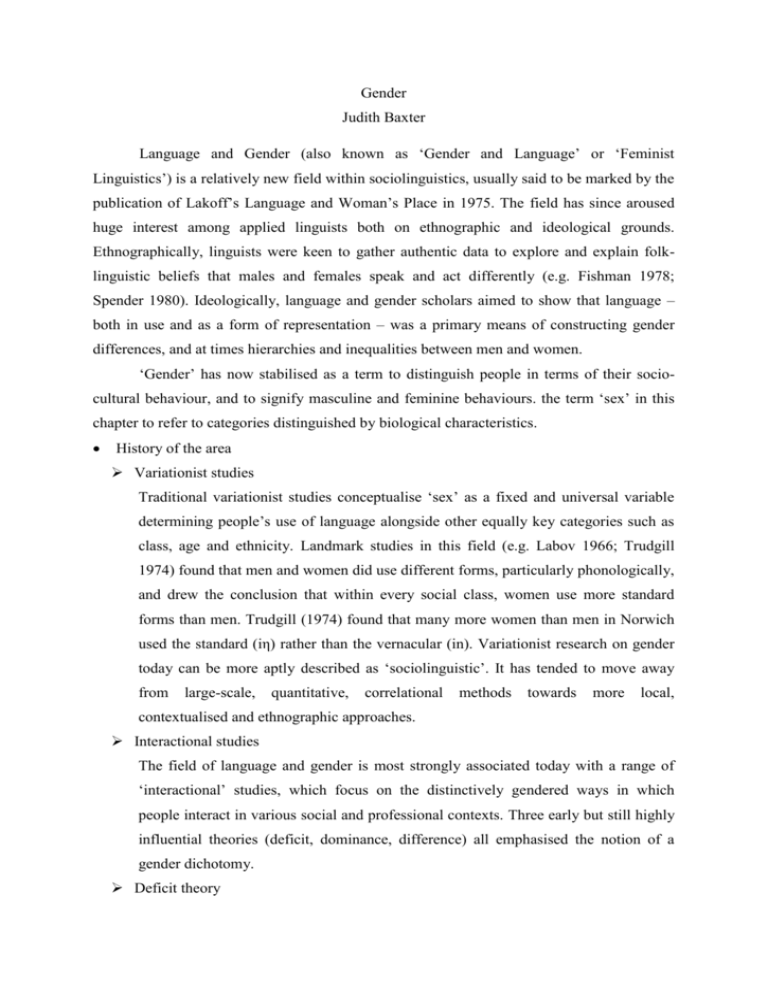
Gender Judith Baxter Language and Gender (also known as ‘Gender and Language’ or ‘Feminist Linguistics’) is a relatively new field within sociolinguistics, usually said to be marked by the publication of Lakoff’s Language and Woman’s Place in 1975. The field has since aroused huge interest among applied linguists both on ethnographic and ideological grounds. Ethnographically, linguists were keen to gather authentic data to explore and explain folklinguistic beliefs that males and females speak and act differently (e.g. Fishman 1978; Spender 1980). Ideologically, language and gender scholars aimed to show that language – both in use and as a form of representation – was a primary means of constructing gender differences, and at times hierarchies and inequalities between men and women. ‘Gender’ has now stabilised as a term to distinguish people in terms of their sociocultural behaviour, and to signify masculine and feminine behaviours. the term ‘sex’ in this chapter to refer to categories distinguished by biological characteristics. History of the area Variationist studies Traditional variationist studies conceptualise ‘sex’ as a fixed and universal variable determining people’s use of language alongside other equally key categories such as class, age and ethnicity. Landmark studies in this field (e.g. Labov 1966; Trudgill 1974) found that men and women did use different forms, particularly phonologically, and drew the conclusion that within every social class, women use more standard forms than men. Trudgill (1974) found that many more women than men in Norwich used the standard (iη) rather than the vernacular (in). Variationist research on gender today can be more aptly described as ‘sociolinguistic’. It has tended to move away from large-scale, quantitative, correlational methods towards more local, contextualised and ethnographic approaches. Interactional studies The field of language and gender is most strongly associated today with a range of ‘interactional’ studies, which focus on the distinctively gendered ways in which people interact in various social and professional contexts. Three early but still highly influential theories (deficit, dominance, difference) all emphasised the notion of a gender dichotomy. Deficit theory Lakoff’s (1975) ‘deficit’ theory posited that from an early age, girls are taught how to use a separate ‘woman’s language’: they are socialised to use language in a ‘ladylike’ way. Dominance theory It has two distinct, parallel branches: language as social interaction and language as a system. In language as social interaction, it considered how gender inequalities were constructed through routine interactions between men and women. Besides language as a system, Spender (1980) argued that language has evolved over the centuries to serve male needs, to represent male interests, and to express male experiences: in short, it is ‘man-made’. She noted three further ways in which the language sustains this andro-centric perspective: linguistic marking of terms to denote women (e.g. manageress, stewardess), semantic derogation (the way terms for women like mistress have become ‘derogated’ or debased over time; also see Schulz 1990), lexical gaps (the lack of a woman-centred lexis to describe certain female experiences in positive ways, such as childlessness or remaining a single woman). Cultural difference theory Maltz and Borker (1982) argued that women and men constitute different ‘subcultures’ learnt through friendly interactions as children in single-sex peer groups. So boys learn how to compete with others for access to ‘the floor’, to use referential, goal-orientated language, and to say things for impact and effect. Girls alternatively learn how to build relationships of equality and trust, to co-operate with others to get things done, and to express feelings and emotions (Maltz and Borker 1982: 207). Main current issues Since the 1990s, language and gender research has firmly distanced itself from gender difference theories, and is, according to Holmes (2007) ‘engulfed in a wave of social constructionism’ emphasising the diversity of gender rather than difference. This ‘postmodern turn’ can partly be explained by the impact of feminism in the West, which has produced profound improvements in the cultural status of women. Social constructionism and the ‘post-modern turn’ Social constructionist theory (e.g. Bergvall et al. 1996; Butler 1990; Crawford 1995; also see Norton, this volume) suggests that males and females are not born, or even simply socialised into a pre-fixed gender identity, but they become gendered through their interactions. The post-modern perspective argues that males and females do not have an individual essence. Any apparent characteristics are the effects we produce by way of particular things we do. Thus, according to Butler (1990), people’s identities are performative. Gender and sexuality Like gender, sexuality is perceived as fluid, multi-faceted and a form of desire/identity that is constructed and performed through speech and behaviour, and not simply determined by the sex of people’s bodies at birth or by early socialisation. One line of research has examined how the hetero-normative principle is achieved through the linguistic performance of heterosexual identities. Gender and sexual identities can be convincingly enacted by a person of any sex, simply by adhering to stereotypical assumptions about male and female language and behaviour. The salience of gender The move away from theories of a ‘women’s language’ or separately gendered speech styles, and towards notions of complex social identities and linguistic diversity has indeed challenged gender as a super-ordinate category. In the ‘local’ corner, theorists of Conversation Analysis (CA) such as Weatherall (2000) argue that an epistemological construct such as gender needs to be made explicitly salient by research participants in order to be considered relevant to any scholarly analysis. In the ‘global’ corner, a number of theorists have challenged the CA premise that unless participants signal their orientation to the salience of gender within linguistic interactions there is no evidence that it is relevant. Other linguists of ‘a post-structuralist turn’ have theorised the continuing salience of gender in more abstract terms. For example, Ochs (1992) used the social semiotic concept of ‘indexing’ (‘pointing to’) to suggest that speaker have a range of ‘linguistic resources’ available to them in order to signal their gender and other aspects of their cultural identities. Future trajectory and new debates The rise of biological essentialism, an extended role for communities of practice, and exploiting the plurality of research methodologies. positive evaluations of women’s talk perpetuate a restrictive, essentialist, gender difference perspective. language and gender scholars should not simply engage in this debate on the level of discourse and social practices; it is important to challenge the factual, scientific evidence and the epistemological bases on which this is produced. A second new direction in the field is a proposal to extend the well-established concept of ‘communities of practice’ (CofPs; Wenger 2000) within language and gender research in order to enable an ‘articulation between the local, the extra-local and the global’ (Eckert and McConnell-Ginet 2007: 28). The second way of extending the CofP concept is relationally, by locating communities of practice in relation to a world beyond – other communities, social networks, institutions and more global, imagined communities. Summing up The field has been driven by a dual mission both to capture ethnographic evidence to argue that gender makes a difference within many linguistic interactions, and to challenge from a feminist standpoint the gendered inequalities that are routinely enacted through language in many contexts. A powerful issue that currently divides the field is the category of ‘woman’ and by association ‘gender’.
